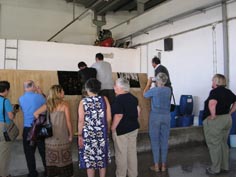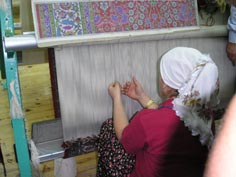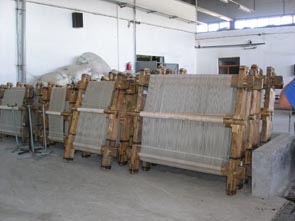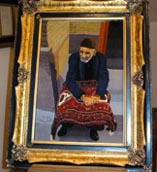|
9/14/05 Day Eight
Konya,
like Homa in Syria, is more conservative. It has 1 million inhabitants.
Imagine our surprise when we flipped through the tv channels on our hotel tv
and came across a female (lesbian?) soft porn channel!Breakfast
in the hotel was good plain yogurt to which I added strawberry preserves,
small pieces of different kinds of cheese, black olives and watermelon.
Lobby full of people chatting and smoking. Radio music pumped up as
background. Mosque –
Meli talked to us about Sufism. A mosque is never closed. A carpet/kilim
hangs over the open door.

Rumi

respected and loved 700 years after his death teachings
were for individuals
humanistic, ecumenicals
born in
1207 in northern Afghanistan on one of the silk routes His
father, a teacher, announced he was going to Mecca after attacks from
Mongolia
Moved to
Baghdad; moved to Damascus (Assyrians); wanted to find land with no heresy
and was told of the “Land of Rum” or Roman. Selcuks introduced tolerance so
the father and a caravan moved again to Anatolia. His reputation came to the
attention of the Sultan in Konya who invited him to his city. The father
rejected his offer of living in a palace and asked for a school instead.
When the father died, students taught the son Persian, Arabic, Hinduism,
Buddhism, math, etc until he reached age 27. The son met a stranger from
Tabriz who had euphony. Asked the son “Who do you know?” not from
books/facts. For many years, they talked. The teacher left.
 Teaching
of Rumi: Teaching
of Rumi:
Religious non conformity
Rules
and dogma of organized religion puts restrictions.
No
duality (not only is man the creation of god but also his reflection)
association with the whirling dervish (whirling represents dynamic/change
and becoming one with God; every individual can do it; orbit like being one
with the universe; do it with music. Mystic and joy you have is a response
for itself. Put up your hands and head up with eyes open to talk with God.
“Be the child of the time.” “Power is love.”
In
Anatolia, 2,5000 years ago, a saying “You cannot get your feet wet twice”
meaning you need to keep changing.For Rumi,
god is in each person’s heart. Perfection is the trinity of wisdom, feeling
and conscience. We begin as perfect human beings and need to maintain it.
Door of love; invited all as they are.When Rumi
was about to die, the Sultan asked where he wanted to be buried. He said in
a cemetery. Son allowed his tomb to be built. Father and other family
members also buried there.
 Lunch in
Konya at Sifa, one of the most liked by locals. We had a delicious main dish
of eggplant, little chunks of meat and great spices with yogurt and rice and
salad (lettuce, onions and tomato). Soup and a yummy dessert like baklava
with singed dough on top. Greeks use honey; Turks use syrup from sugar water
and lemon. Lunch in
Konya at Sifa, one of the most liked by locals. We had a delicious main dish
of eggplant, little chunks of meat and great spices with yogurt and rice and
salad (lettuce, onions and tomato). Soup and a yummy dessert like baklava
with singed dough on top. Greeks use honey; Turks use syrup from sugar water
and lemon.
 Heading
south. Flat land. Sugar beets, black cabbage, irrigation provided free. Heading
south. Flat land. Sugar beets, black cabbage, irrigation provided free.
Catalhoyuk
Life for
thousands of years found Byzantine tombs
Obsidian
(natural volcanic glass) mirrors, flint daggers from the Neolithic Era
pottery
vessel among the oldest in Anatolia
 Photo of
a carved wood box, found as carbonized wood preserved by fire= deposits in
which they were buried. No central building. No ceremonial center. Ancestors
were buried beneath floors in houses. Had 8,000 people. Moved across roofs;
no streets. Photo of
a carved wood box, found as carbonized wood preserved by fire= deposits in
which they were buried. No central building. No ceremonial center. Ancestors
were buried beneath floors in houses. Had 8,000 people. Moved across roofs;
no streets.
Medical
system:
State
should provide health services; not sufficient; long lines in cities sate will
pay to have a patient treated abroad...
child/mother care in every town.
Vaccinations are widespread; touring dentists and optometrists visit schools one
person can stay in a hospital with a patient; don’t have family doctors. Retirement women
after 20 years of working. Meli
stopped to buy fresh melons from a roadside cart. Returned to antique store
– Karavan. Bought a carpet from Konya Obruk village, 45 km away. It is a
traditional design related to good luck with cowry shells.
Dinner at
Gulbahce terrace restaurant facing Rumi’s tomb with cobalt and lead blue
tower. Ate spicy tomato and yogurt; lentil soup; think pizza like slices;
rice and delicious lamb
|
![]()
